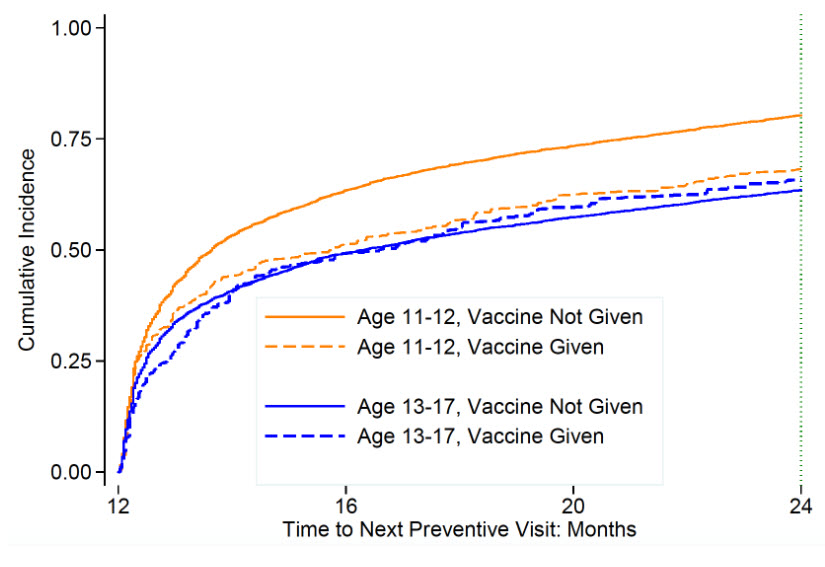Fiks AG, Hannan C, Kelly MK, Stephens-Shields AJ, Localio R, Grundmeier RW, Shone LP, Steffes J, Wright M, Breck A, Rand C, Albertin C, Humiston SG, McFarland G, Abney DE, Szilagyi PG
Accepted for 2020 Pediatric Academic Societies Annual Meeting
Background: In young children, vaccination at acute primary care visits can be associated with a decrease in subsequent preventive care. This association has not been examined for adolescent human papillomavirus (HPV) vaccination, recommended at all types of visits, including acute visits.
Aims: Evaluate the association of HPV vaccination at acute visits with receipt of subsequent adolescent preventive care visits.
Methods: As part of the NIH-funded STOP-HPV trial, we extracted electronic health record (EHR) data from 48 pediatric primary care practices across 19 states in the American Academy of Pediatrics (AAP) Pediatric Research in Office Settings (PROS) national pediatric primary care network. Using baseline data, we identified all adolescents with an initial preventive (index) visit followed by an acute visit at which HPV vaccine was due within the next 12 months. We then assessed the association between HPV vaccination at the acute visit and (1) receipt of a preventive care visit 12-24 months following the index preventive visit using Chi Square tests and (2) timeliness of the preventive care visit between 12-24 months using inverse probability-weighted cumulative incidence plots, with weights standardized by practice site, HPV vaccine dose, adolescent sex and age in years. Results were stratified by age group (11-12 (younger) versus 13-17 years (older)).
Results: Analyses included 15,419 adolescents (48% female, 10% African American, 17% Hispanic, 51% 11-12 years old). Among younger adolescents, those who received HPV vaccine at an acute visit were less likely to have subsequent preventive care visits compared to those not vaccinated (80.6% and 85.4%, respectively; (Risk difference (RD) of -4.8%, 95% CI: -7.4%, -2.1%) (Table 1)). Among older adolescents, vaccination at acute visits was not associated with a reduction in subsequent preventive care visits (65.7% and 68.4%, respectively; (RD -2.7%, 95% CI: -6.1, 0.1)). For younger adolescents (p<.01), but not older (p=.5), HPV vaccination at acute visits was associated with a delay in receipt of subsequent preventive care. (Figure 1). The median time difference was 2.1 months.
Conclusion: Acute visit HPV vaccination is associated with delayed subsequent preventive care for younger, but not older adolescents. HPV vaccination during acute visits should be accompanied by education and reminders for adolescents to return for timely preventive care visits.
Table 1. Association of Acute Visit HPV Vaccination with Any Preventive Care *All adolescents are due for preventive care 12 months following their prior preventive care visit.
*All adolescents are due for preventive care 12 months following their prior preventive care visit.
Figure 1. Time to Preventive Care by Receipt of Acute Visit Vaccination, Stratified by Age
Last Updated
05/20/2020
Source
American Academy of Pediatrics